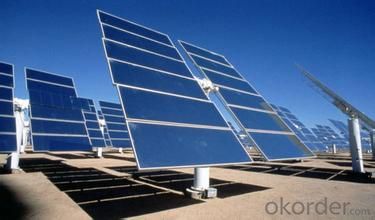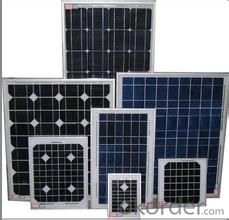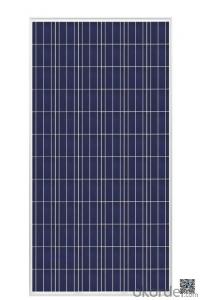SOLAR PANELS,SOLAR PANEL POLY,SOLAR MODULE IN CHINA
- Loading Port:
- Shanghai
- Payment Terms:
- TT OR LC
- Min Order Qty:
- 2600 watt
- Supply Capability:
- 26000 watt/month
OKorder Service Pledge
OKorder Financial Service
You Might Also Like
Item specifice
We now provide
• Monocrystalline Solar Panel
• Polycrystalline Solar Panel( multicrystalline silicon Solar Panel)
Features of our products:
• High conversion efficiency mono/poly-crystalline amorphous silicon solar cells
• Modules incorporate high performance bypass diodes to minimize the power drop caused by shading
• High transmittance, low-iron tempered glass
• High performance EVA encapsulant to prevent destroying and water.
• AI frame: without screw, corner connection. 8 holes on the frame can be installed easily
• Good performance of preventing from atrocious weather such as wind and hails


Polycrystalline Silicon Solar Modules 48Cell-195W Specification
ELECTRICAL PERFORMANCE | |||
Power output | P max | W | 195 |
Power output tolerances | ΔP max | W | 0/+5 |
Module effi ciency | η m | % | 14.7 |
Voltage at Pmax | V mpp | V | 23.7 |
Current at Pmax | I mpp | A | 8.03 |
Open-circuit voltage | V oc | V | 30.1 |
Short-circuit current | I sc | A | 8.65 |
Product Description:
This installation Manual contains essential information for the electrical and mechanical installation that your must know before installing CUSTOMER PV modules. This also contains safety information you need to be familiar with .All the information described in this manual are the intellectual property of CNBM and based on the technologies and experiences that have been acquired and accumulated in the long history of CUSTOMER. This document does not constitute a warranty, expressed or implied.
CUSTOMER does not assume responsibility and expressly disclaims liability for loss, damage, or expense arising out of in anyway connected with installation, operation, use or maintenance of the PV modules. No responsibility is assumed by CUSTOMER for any infringement of patents or other rights of third parties that may result from use of PV module.
CUSTOMER reserves the right to make changes to the product, specifications or installation manual without prior notice.
Solar panel working process
In addition to being the ultimate source of all life on earth, the sun is an infinitely renewable, completely pollution-free source of electricity. Instead of burning fossil fuels dug up from the ground in a big power plant – a very 19th century, industrial age approach, when you think about it – solar panels convert sunlight directly into electricity, with no harmful emissions.
The basic unit of a solar panel is a solar cell, which usually consists of one or two layers of silicon-based semiconductor wafers. When struck by the photons in sunlight, the solar cell generates an electrical charge due to the "photovoltaic effect" – which is a pretty good name, since it produces voltage from photons. The flow of these electrons moves in a steady electrical current from one side of the cell to the other.
Dozens of these PV cells are packaged together into solar modules, which in turn are packaged into solar panels that are mounted on a rooftop and arranged to maximize their hours of exposure to direct sunlight. Because the electricity generated by all those solar cells is direct current (DC), it is then sent to an inverter that transforms the power into the same alternating current (AC) used by the appliances in your home and the local utility electricity distribution grid. Increasingly, these inverters are getting "smart," providing data monitoring for solar installation performance and other grid integration services.
- Q:How do solar panels affect the property's energy management strategy?
- Solar panels can have a significant impact on a property's energy management strategy. By harnessing the sun's energy, solar panels generate clean and renewable electricity, reducing the property's dependence on traditional power sources. This can lead to lower energy costs, increased energy independence, and a reduced carbon footprint. Solar panels also provide a stable and reliable source of energy, allowing for better energy planning and management. Additionally, excess energy generated by solar panels can be stored or sold back to the grid, providing additional financial benefits. Overall, solar panels play a crucial role in shaping and optimizing a property's energy management strategy.
- Q:Can solar panels be installed in areas with frequent power outages?
- Yes, solar panels can be installed in areas with frequent power outages. In fact, solar panels can be a great solution for such areas as they generate electricity from sunlight, reducing dependency on the grid. With the addition of energy storage systems, solar panels can provide uninterrupted power supply during outages, making them a reliable and sustainable option.
- Q:Is it really possible for me living in Denver to build and install and setup my own solar panel to help make electricity for my home?
- I honestly don't know but I have done lots of internet searches and there are several site where you can buy the plans to do this for around $49 and in the blurb it says that the hardware is very cheap to buy too. These are american based sites saying that all the hardware is easily available so why not give it a try though it could all be a con - $49 dollars might be worth a try
- Q:Our school is in the process of being built, but they have no plans to include any environmental benefits. I was wondering how to get a grant for solar panels (at least) or who I can talk to in order to get a grant.
- Excessively long payback schemes for solar panels are being quoted. It depends on where you live, where you situate your solar panels, what you buy and if you get a grant or install them yourself. Much of the cost of Solar panels is in the installation. Any competent DIY person can install a simple solar panel system. Ours cost less than ?000 to buy and self install. What are you calling payback time? Because each time I don't use fossil fuels and use solar energy instead, I don't get a 'fossil fuel' bill. Whilst we still use some electricity for running a fridge, lighting etc we have no other fuel bills, no gas, no oil, no electric heating no electrically heated hot water. We have woodburning stoves (which run on free wood) and solar. Remember you are not just paying for the electricity/gas/oil etc that you use, you are also paying standing charges, VAT etc. Include those in your 'payback time figures' and you will see a very different picture. How long would it take you to pay back ?,000 if you only had one tiny electric bill each quarter?
- Q:Can you please tell me how much a solar panel costs?Please back up your info with a website.
- Have okorder . Possibly this could immediately instruct each and every one!
- Q:I know that if I put solar panels in my home I will get 30% back from the govt. Does that mean if I pay 2K I will get back around a 3K check? Or will my income play a roll where I may not get back as much?
- It's not your income, but the tax you pay. This is a NON refundable credit. You won't see a difference unless you actually owe tax. If you are retired and living on social security and savings, you don't pay tax, so you'd get $0 from the solar panels. If you are married, have a bunch of kids and get a refund of all money withheld anyway, you'd get $0 from the solar panels. If you currently average, say $200 in actual income tax, your $2,000 investment would create a $3600 tax credit, but you'd only get back $200 the first year. (This would reduce the tax bill, increasing any refund of money already withheld to pay that tax bill.) The remaining amount would carry forward to 202. You can keep carrying it forward as long as the credit is available (I think that's currently 206). Get your 200 return out and get form 5695 and run the numbers. Edit, ignore TRO. She doesn't keep up with tax law changes. BOTH the residential and solar credits exist in 20. The Residential credit now limited to $500.
- Q:A homeowner is considering putting a horizontal solar panel on her roof to heat water for domestic use. An average increase of water temperature each day from 60oF to 20oF is wanted for 50 gallons. How large a panel would be needed on a clear winter day at 40o latitude if the overall efficiency is 50%?
- Good points. I'm new to the solar energy world, but solar just makes sense. Who wouldn't want to make it work? The more I learn the more I think its a great alternative to some of the energy we use. This info really helps.
- Q:I'm thinking of getting a solar panel for my house to help cut back on power use (I live in New Mexico). What sort of appliances can I run on a watt solar panel? Is it worth it to get a single watt panel or is it more efficient to get a multi-watt panel?
- You can run a lot of things. If you set the system to charge batteries when you are not using anything, they will charge effectively. You can use the system for lighting, LED lighting direct from the battery power is most effient since LEDs are low voltage devices with a very long life span. I replaced a 2 tube flourescent trough with four 5Watt PowerLEDs for example, While I have it on 20VAC at the moment, I can move it to 2 VDC power with ease, and had set it up to run initially on 2 volt sources. There are also many 2 volt appliances as well. You can even convert some of those all in one stereo systems to operate on 2 volts by eliminating the power supply. You will actually use less power by doing so. You will not be able to blow the shingles off the roof unless you add a Class D amplifier to the output, but for most listening, the output is adequate. Some small TV's these days can be run from 2 volt sources, if not directly, then with a buckboost inverter for a laptop. The small TVs only draw about 30 to 45 Watts. Skip the idea of using an inverter, they are not efficient at small loads, and represent additional load on the system. So with a little bit of planning, you can run a lot from that 60 Watt system. You can at least take some bite out of the electric bill for mundane lighting. You can also use them to keep power up on a battery system for lighting in a remote barn. The uses are only limited by your imagination and creativity.
- Q:a) i'd like to get a solar panel to make this thing i saw in popular science, it was a bag that had a solar panel in the side (you just attach it with grommets into a clear vinyl pocket you make. its for charging elecronics and stuff) and i was wondering what kind i should look at, do they come flexible? can i get them on OKorder? what kind of wattage should i look for (btw it also had a little voltage regulator and stuff to make a little usb in your bag) so any info on that!b) i was thinking about like putting solar panels on my roof, where can i look into that, is that a good choice, has anyone done it, how did it work out? thank you, just curious
- For okorder / for information on how to hooke it up your self. It is a DIY site.
- Q:I have just made my first dolar panel 20 watts, charges my 27TMX Trojan battery perfectly. Now I am thinking to build more solar panels for a grid tie installation at my house, maybe 5 panels would do it, is this safe?
- Congratulations on your solar panel. It takes a lot of work to construct one. Tying to the electric grid requires permission from your power company, and conformance to local building codes. This generally means compliance with the National Electrical Code (NEC), meaning your panels must be UL (or similar rating from another standard) listed, for fire and electrical safety reasons. Homemade panels won't qualify, unfortunately. I really would discourage you from trying to do a jungle installation without permission, as the power distribution in a house is nothing to be trifled with. That would also likely void your homeowner's insurance, and give the bank a reason to call your mortgage, if you have these.
1. Manufacturer Overview |
|
|---|---|
| Location | |
| Year Established | |
| Annual Output Value | |
| Main Markets | |
| Company Certifications | |
2. Manufacturer Certificates |
|
|---|---|
| a) Certification Name | |
| Range | |
| Reference | |
| Validity Period | |
3. Manufacturer Capability |
|
|---|---|
| a)Trade Capacity | |
| Nearest Port | |
| Export Percentage | |
| No.of Employees in Trade Department | |
| Language Spoken: | |
| b)Factory Information | |
| Factory Size: | |
| No. of Production Lines | |
| Contract Manufacturing | |
| Product Price Range | |
Send your message to us
SOLAR PANELS,SOLAR PANEL POLY,SOLAR MODULE IN CHINA
- Loading Port:
- Shanghai
- Payment Terms:
- TT OR LC
- Min Order Qty:
- 2600 watt
- Supply Capability:
- 26000 watt/month
OKorder Service Pledge
OKorder Financial Service
Similar products
New products
Hot products
Hot Searches
Related keywords




























